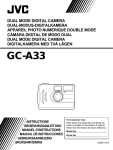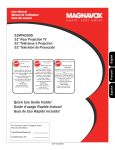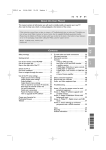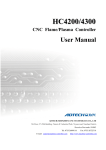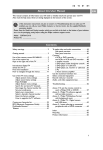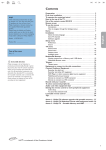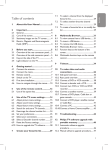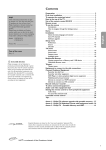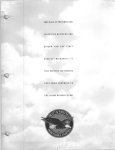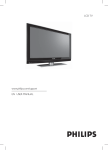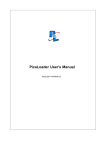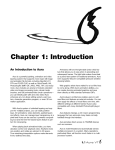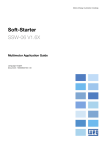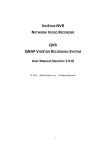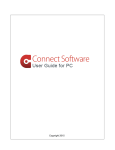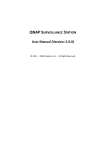Download Sunroof Repair This document is the text/images from the TSB
Transcript
Sunroof Repair This document is the text/images from the TSB (technical service bulletin) issued by Infiniti concerning the repair procedure for sunroof issues. Be advised that this is a LARGE, TIME-CONSUMING project. Plan to do this over a weekend. I found some omissions in the TSB that were significant and caused me to waste a lot of time trying to figure things out on my own. With the TSB and my additions, you should be able to do this in much less time than it took me. Any text in italics signify my inserted comments/clarification regarding the different TSB steps. My inserted images will be designated by a prefix of PIC (example – “see image PIC 001”). The original TSB Images are named “Figure xx”. Sunroof Repair TSB The sunroof repair kit available for the J30 is part number 91350-10Y20. See images at bottom of document. SERVICE INFORMATION If an applied vehicle exhibits the following symptoms, use the service procedure below to resolve the incident(s). - Sunroof binds - Sunroof motor runs but the sunroof will not open or close - Sunroof leaks 1. Operate or move the sunroof until it reaches the fully closed position (not tilted position). 2. Remove the sunroof lid (glass), sunroof shade, and headliner. Refer to the BT or BF section of the applicable service manual. This TSB was written to cover several Infiniti models. The J30 has no sunroof shade and the sunroof lid is not glass but metal. I removed the sunroof rail assembly with the sunroof lid attached to the rail assembly. It makes the unit heavier to take out of the car but makes the removal of the sunroof lid easier with the rail and lid out of the car. Believe it or not, the bulk of the work involves the removal of the headliner. This is because you’ll have to remove the seats and side trim to get to the headliner. Here I will detail everything you have to do in order to remove the headliner. A. Remove the front seats. These are attached with four bolts. Once you remove the bolts, tilt the seat towards the back seat. This will allow you access under the seat to disconnect the wiring harnesses. The driver side seat has two wiring harnesses, the passenger side has a single harness. Be careful when removing the seat from the car. The seat legs are very sharp and can damage the door trim. Do not attempt to carry the seat by holding the headrest. The front seats are fairly heavy and the weight can cause the headrest to move while your holding it. Figure PIC001 shows the front seat removed. PIC 001 B. Remove the back seat. The back seat is made up of two sections. The lower portion (where your butt would sit) and the upper section (where your back would be). The lower section comes out first. To remove it, remove the two bolts by the carpet. Please note – the bracket that holds the seat has two openings, one for the bolt and one for a metal tab. You will need to bend this metal tab towards you before you can lift up on the seat (see figure PIC002). Otherwise the metal tab keeps the seat from sliding up and out of the bracket. Once this tab is bent, you can just lift the seat out. To remove the upper portion of the back seat - remove the five Phillips screws that hold it in place. Lower the back seat armrest. That will expose a piece of trim that flips open (push on the top of the trim to flip it open). There are two additional screws behind this trim. Push the seat back towards the ceiling of the car and the seat should pop right out (See figure PIC003). PIC 002 PIC 003 C. Remove the kick-plates (chrome trim over the carpet in each door opening) by each door. The kick-plates are held in place by metal clips. D. Remove the lower portion of trim that sits between the front and rear doors. Pull straight back on it. It’s simply held in place by metal clips. See figure PIC 004. Note that there’s a foam piece that will likely fall out. You need to glue it back in place. Both of mine fell out. See figure PIC 005. PIC 004 PIC 005 E. Pop out the A-pillar trim. Again this is held by two metal clips. One clip on top, the other clip above the tweeter. You DO NOT want to remove this trim piece. Just pop it out so it will be out of the way when you get ready to remove the headliner. This part needs to stay in the car, just unclip it. See figures PIC 006 and PIC 007. PIC006 PIC007 F. Remove the weather stripping/molding from around each of the four doors. It just slides out. You’ll need to loosen a piece of trim by the driver and passenger foot well (circled in green) to get the trim out. See figure PIC 008. PIC 008 G. Remove upper portion of trim between the front and rear doors. Again, this is held in place by metal clips. Pull straight back on it. See figure PIC 009. H. Remove dome light. See figure PIC 010. PIC009 PIC 010 I. Pop upper-rear trim. You don’t need to fully remove these pieces. Just get them out of the way but leave them in place. There are two metal clips holding this in place. See figure PIC 011. J. Remove side-handles from headliner. See figure PIC 012. PIC 011 PIC 012 K. Remove sunroof controls. This part just pulls down. See figure PIC 013. L. Remove rear-view mirror. This is attached with Philips screws. See figure PIC 014. PIC 013 PIC 014 M. Remove vanity mirrors. These are held in place by Phillips screws. See figure PIC 015. N. You’re finally ready to pull down the headliner. Pull straight down on the very back of the headliner to release some clips (the part of the headliner closest to the car’s rear window). Now, pull down on the headliner portion that surrounds the sunroof opening. Three of the four sides around the sunroof opening hold the headliner with Velcro strips. The fourth side (the side closest to the rear window) holds the headliner with metal clips. Do not pull down on the side with the metal clips. Simply slide the entire headliner towards the front of the car. This should cause the headliner to slide off these last set of clips. I could not figure out a way to take the headliner out of the car. Maybe you can. I left the headliner in the car and just moved around it. It became a real pain to maneuver around it. Figure PIC 016 shows the headliner removed. PIC 015 PIC 016 3. Remove the sunroof rail assembly from the vehicle and place it on a flat working surface. IMPORTANT: Observe the following cautions when handling or working on the sunroof rail assembly. - Do not pick the sunroof rail assembly up by the drain tray as damage may occur to the drain tray (see Figure 2). - Do not place the sunroof rail assembly on its end as damage to the corner drains may occur (see Figure 3). - Do not press on the sunroof rail assembly cross members as they may bend (see Figure 4). Before you remove the sunroof from the car, it may be a good idea to mark the location of the four brackets that secure back portion of the rail to the roof. Mark the location of the bracket in relation to the roof of your car as well and the location of the bolts. This will be helpful when putting everything back. These four brackets are used to do slight adjustments for the location of the sunroof. Hopefully, by marking the location of these, you won’t have to waste time adjusting the location of the rail assembly when putting things back together. See figure PIC 017. Also, note that the bolts holding the sunroof rail have a notched-opening on the driver side of the sunroof (figure PIC 018). The bolts on the passenger side are NOT notched. Remove all but one of the bolts on the passenger side. On the driver side, just loosen the bolts in the notched openings. Once you’re ready to pull the rail out of the car, have a friend hold the driver-side of the sunroof rail while you remove the last bolt on the passenger side. This will cause the passenger side of the rail to drop down. Hold it! Now, the driver side is still being held by all the loose bolts in the notched openings. Simply let the passenger side drop down while you slide the driver side out of the notches. I pulled the sunroof rail out of the passenger-side rear door. Stand the sunroof on it’s side (NOT THE SIDE WITH THE PLASTIC DRAIN HOLES – preferably the side with no notches - that way the notches don’t scratch the bottom of the door opening. Slide the rail assembly out the door. PIC 017 PIC 018 4. Remove the motor from the sunroof rail assembly. If you didn’t remove the sunroof lid back in step 1, leave the motor on the rail assembly for now, you’ll need to use now. If you removed the sunroof lid already, continue with step 5. Ok, if you’re here, you need to remove the sunroof lid from the rail assembly. This step took me hours to figure out. In any case, here’s the trick. In order to remove the sunroof lid from the rail assembly, you will have to open the sunroof about ¾ of the way. You’re thinking, the sunroof rail is no longer connected to the car! I did this by attaching a set of jumper cables from the car battery to the two wires coming off the sunroof motor. The blue wire is your ground (-) and the red wire is your positive (+). Attach the sunroof switch assembly to your motor and use it to open (not tilt) the sunroof. The sunroof lid is attached to the rear guide by six bolts, three on each side. The rear guide is the bracket that slides back and forth on the sunroof rail when you open/close your sunroof. They’re the black metal parts that came in your repair kit with that cable attached to them. The bolts holding your sunroof lid attached to the rear guides are located behind the felt liner on the sunroof lid (the part of the sunroof lid that faces the inside of the car and has the same material as the headliner). In other words, the screws are sandwiched between the sunroof lid and the felt liner. To get access to these screws, you’ll have to slide the felt liner towards the back of the sunroof. To release the felt liner from the sunroof lid you’ll need to insert a screwdriver in the front of the sunroof opening (between the sunroof lid and the felt liner – See figure PIC 019) to pry up two plastic clips holding the felt liner to the sunroof lid. The clips are located on the left and right side of the opening (driver and passenger sides). As you lift up the clip, apply pressure on the felt liner towards the back of the sunroof. Do this on both sides and the felt liner will slide back exposing four of the six screws. See figure PIC 020). Figure PIC 021 shows what the clip looks like. PIC 019 PIC 020 PIC 021 To get to the last screw, you’ll have to slide the felt liner further back. You’ll notice that the liner will catch on something. This “something” is another set of clips. These clips are located on the edges of the little felt liner pop-up opening (the piece of the felt liner that pops up when you tilt the sunroof open). Push these clips up and the felt liner should slide all the way back. You may have to close the sunroof door to expose the last two screws. I ended up completely removing the felt liner out of the rail assembly by sliding it all the way out the back of the rail. That’s how I was able to take the photo seen in figure PIC 021. Now that you have the sunroof lid removed. Make sure you “close” the sunroof door (without the lid). You’re just making sure the sunroof motor is in the closed position. With, the motor in the closed position, you can remove the motor from the sunroof rail assembly. 5. Confirm the closed position marks on the motor are lined up with each other (see Figure 5). A. If the closed position marks are lined up, proceed with step 6. B. If the closed position marks are not lined up, turn the motor adjustment screw (see Figure 5) until the marks are aligned, then proceed with step 6. 6. Remove the stoppers from the rear of the sunroof rail assembly as follows: A. Loosen (but do not remove) the screw in the end of the stopper (see Figure 6). B. Remove the screw on the top of the stopper (see Figure 6). C. Slide the stopper out of the sunroof rail assembly (see Figure 6). 7. Remove the drain tray as follows: A. Remove two screws that secure the drain tray to the drain guides (see Figure 7). B. Lift up and pull forward on the front of the drain tray to remove it from the drain guides (see Figure 7). 8. Insert a screwdriver and pull each guide out of the sunroof rail assembly until the cable is removed (see Figure 8). The drain guide will come out automatically as the guide is removed. NOTE: If the old cable is broken, wait to remove it when you install the new cables (see step 16). It is easier than fishing it out now. 9. Remove any debris found in the sunroof rail after the cable is removed. Also, carefully smooth out any burrs or nicks on the sunroof rail with a file. NOTE: Do not remove the existing grease from the sunroof rail, but only remove the debris. Also, do not use any cleaners/solvents on the sunroof rail. NOTE: When filing burrs or nicks, use caution not to get metal filings in the sunroof rail grease. Cover the grease with a rag or with tape. 10. If damaged or missing, install new guide links in the guide link slots (see Figure 9). NOTE: Step 11 below only applies to I30 and QX4. 11. If damaged or missing, install two new front silencers (see Figure 10). NOTE: Steps 12 and 13 below only apply to QX4. 12. Install the new damper (on the empty metal tab) on the rear of the sunroof rail assembly (see Figure 11). NOTE: When installing the damper, first insert the front portion of the damper into the hole in the cross member, then push the damper over the metal tab until it is fully seated. 13. Install two additional resistors on the sunroof rail assembly (see Figure 12). NOTE: Most QX4 vehicles already have two resistors mounted to either the front or rear of the sunroof rail assembly. Install two additional resistors (provided in the kit) so the sunroof rail assembly has four resistors when you are done. 14. Install the new white plastic shoes on the new rear guide assemblies (see Figure 13). NOTE: Install the white plastic shoes so the tabs face each other (see Figure 13). 15. Apply silicone grease 16. Install the new rear guides as follows: A. Slide the rear guide cable into the sunroof rail assembly. NOTE: The passenger side rear guide cable slides into the outside rail track and the driver side rear guide cable slides into the inside rail track (see Figure 14). NOTE: If the original cable was broken and still remains in the sunroof rail assembly, push the new cable into the sunroof rail assembly until it pushes the broken cable to the guide link slot, then use pliers to pull the old cable out through the slot (see Figure 15). B. First, insert the front of the new rear guide into the sunroof rail (see Figure 16), then pull the guide towards the front of the sunroof rail assembly until the rear guide slides into the sunroof rail (see Figure 17). Make sure the mold pin is placed on top of the rail (see Figure 18) when inserting the rear guide. NOTE: Squeeze the tabs on the white shoes together while inserting the rear guide into the sunroof rail. 17. Verify the rear guides slide smoothly and quietly in the sunroof rail assembly, then move the guides completely forward. 18. Insert the new drain guides into the rear of the sunroof rail assembly as follows: A. Push the stopper in the "A" direction while squeezing the clips in the "B" direction (see Figure 19). B. Insert the drain guide into the end of the sunroof rail assembly (see Figure 19) and slide it forward until it snaps into the cut-out in the rail. 19. Re-install the rear stoppers. 20. Wipe off the sunroof cross members with a clean cloth. 21. Wipe any debris out of the drain channels (troughs). See Figure 19 above. 22. Move the rear guide until the holes on the rear guide and link line up with each other (see Figure 20). 23. Insert a 3 mm punch or pin through the holes to make sure they are completely aligned (see Figure 20). To get these holes to line up, you’ll have to either pull or push on the rear of the rear guide while keeping the front of the guide from moving. This hole alignment ensures that your lid is not incorrectly tilted too far up or down. I tried VERY hard to get these holes to line up but could never get the thing to move. You can skip this step. I have a fix for this later. 24. Re-install the motor on the sunroof rail assembly. NOTE: Make sure the closed position marks on the motor are still lined up with each other before installing the motor on the sunroof rail assembly. If necessary, turn the motor adjustment screw until the marks are aligned. 25. Re-install the sunshade in the sunroof rail assembly. Refer to the BT section of the applicable service manual. NOTE: The sunshade brackets ride on the lower, longer slots in the rail. 26. Re-install the drain tray (see Figure 7). 27. Re-install the sunroof rail assembly in the vehicle. Refer to the BT section of the applicable service manual. 28. Wipe off the outer rubber seal on the sunroof lid (glass). NOTE: Do not use cleaners/solvents to clean the sunroof outer rubber seal as they can cause the rubber to dry out and crack. 29. Re-install the sunroof lid (glass). You may have to adjust the sunroof lid forward or backward to get it to line up with the opening. If this is the case, slide the felt liner back and loosen the six bolts (3 per rear guide) that hold the lid in place and adjust as needed. 30. Check the operation of the sunroof. If you could not get the holes to line up in step 23, you will notice that your sunroof lid does not line up with the roof opening in your car. It’s tilted too far up or down when the sunroof switch is in the fully closed position (tilted all the way down). The solution is simple. Simply use the tilt switch to tilt your window up or down until it lines up with the car’s roof opening. Once the lid is lined up with the roof opening, leave the switch alone and remove the sunroof motor from the rail assembly. Now, with the motor removed from the rail assembly but still connected to the power source and switch assembly, hit the switch and place the motor in it’s fully closed, un-tilted position. Now that the motor is sitting in its closed position, re-attach it to the sunroof rail. Now when you tilt the lid up and back down, it should line up with the roof opening. 31. Re-install the headliner.


















